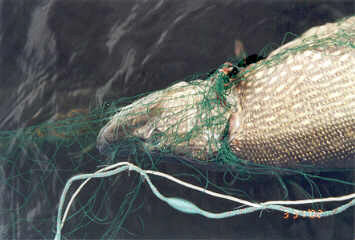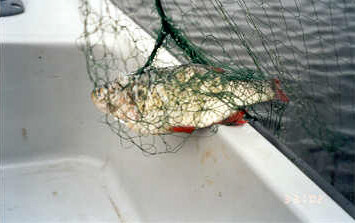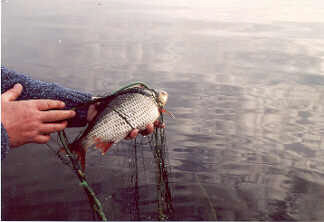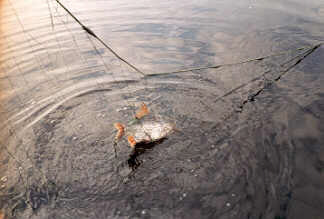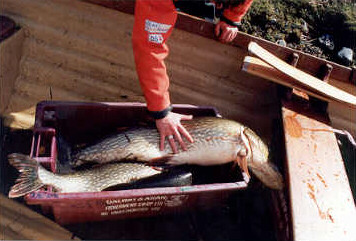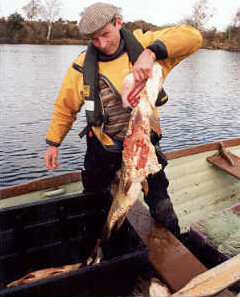
|
2.0 Factors Impacting on the Pike Resource 2.1
POLLUTION Eutrophication, or nutrient enrichment, is the principal threat to the water quality of Irish lakes. This form of pollution is caused by the inputs of nutrients, principally phosphorus, either directly to lakes or more commonly through the inflowing rivers, at concentrations well in excess of natural levels. Eutrophication results in excessive production of planktonic forms of algae, Cyanobacteria (formerly known as blue-green algae) and macrophytes (rooted plants) offshore and may also lead to increased growths of macrophytes and attached algae on and near shorelines, especially near the mouths of nutrient enriched streams. The planktonic growths can cause a marked reduction in light penetration through the water column and also lead to oxygen depletion in the deeper layers during periods of stratification, as the dead cells sink to the bottom and decay. Numerous EPA reports confirm that while inputs from sewage and, to a lesser extent industry, contribute to eutrophication, discharges from agricultural sources are largely responsible for the upward trend in the incidence of pollution. Ill timed application of fertilizer to surrounding land and farm yard run off are primary examples. Salmonids are the most sensitive of freshwater fishes to the effects of pollution. The western lakes and other brown trout fisheries such as Sheelin once enjoyed oligotrophic or pristine status. This was reflected in the quality of both brown trout and salmon catches from these waters. However, the EPA's latest report classes Sheelin as highly eutrophic while Loughs Corrib, Mask and Conn have been classified as Mesotrophic with Mask in particular sliding away from its once pristine state very quickly. The current state of these lakes is far from ideal with respect to salmonid habitat and the continuing decline and further destruction of spawning redds does not bode well for the future. Silting due to enrichment of once clean gravel runs ideal for spawning is now a major issue. Stocked trout are not an answer and uneconomic in the longer term. The survival rate of the limited fry that manage to hatch in such an unfavourable environment is dismal. In the current economic climate replacing this potential stock with reared fish is not viable, the environmental conditions being far from ideal for these fish also. Coarse fish species while being more tolerant of an enriched environment are also suffering at the hands of pollution as is suggested by catch reports on the Shannon system as recently as 2002. Bream appeared to disappear from many hotspots. When significant catches did finally begin very late in the season many of the fish were in very poor condition with red sores appearing along their flanks and a loss of weight. Authorities have suggested that this was a viral disease but caused by what? Pollution perhaps. 2.1.1 The Western Lakes and waters such as Lough Sheelin were in the past, Europe's best wild brown trout fisheries. They were also the worlds best big pike fisheries. Both species lived side by side and complimented each other in achieving a fine balance. In the past the Shannon and Erne and their adjoining lake systems were the best coarse fisheries in the world and also produced big pike. Again coarse fish species lived side by side with pike and struck a fine balance. The fisheries were not overrun by any one species. Declining trout stocks on Ireland's wild brown trout fisheries has been attributed to predation by pike but pike have been there for centuries and there is ample evidence to suggest that fine trout fishing was experienced until recently. The common thread is the increasing levels of pollution, not the increasing predation from pike as has been suggested by the fisheries boards. Many independent reports from organizations such as the EPA and Greenpeace have confirmed this. Sheelin has now suffered a further blow as it is overrun with jack pike, which are doing untold damage to all fish stocks in the lough as they are unpoliced by their larger brethren who have been removed by gill nets. The pike has been made a scapegoat for unwillingness to address the real problem by the boards and avoid crossing swords with local authorities and other inept state agencies. Ireland's pike angling resource is one that requires little management and resources yet has the potential to return great rewards if marketed correctly. The resources used to manage the labour intensive action of predator control would be better spent trying to address the pollution problem while at the same time the pike stocks could recover and generate an alternative source of revenue until such a time as trout stocks recover and the loughs they inhabit provide a reasonable environment for the survival of all fish species. 2.1.2 2.2 PIKE
CULLING · Perception of potential tourists that Irish authorities have no
respect for the pike species or in using the pike species to attract
overseas pike anglers
2.3 PIKE TRANSFER However moving pike to other waters i.e. recipient waters will impact upon the balances existing within those waters. Increasing the number of pike within a water that is already balanced will put extra pressure on the available prey fish and thereby in time limit the size of pike within that water. The transfer of pike in the view of the Irish Pike Organisations creates knock on effects, which strongly suggest no transfer should take place, instead placing more emphasis on habitat protection, pollution and water quality problems. Further on in the submission though, we have proposed a transfer policy in which the views above are taken into consideration on particular waters and where stocks need to re-established .
2.4 PIKE DISEASE Results obtained from the Pike angling consultation document,
which was distributed in November 2001, indicates a worrying trend,
that of a Pike population suffering from various health defects. 69%
of Pike anglers who returned forms commented on catching Pike with
lesions, sores, growths and fungus. The bulk of the tumours or
lesions found in Pike are now believed to be malignant lymphomas or
Cancers. · Page 5 states:- However, the Board undertook no serious attempt at scientific
research into these diseases. Prof. Maire Mulcahy reported lymphoma in Pike in Ireland in 1963. In Ireland, Pike lymphoma has been found in all major areas of Pike distributions with an incidence of up to 12.5%. Funded by Enterprise Ireland, Prof. Maire Mulcahy UCC and Dr. Sean Callanan UCD have recently supervised a three year study into the suspected viral association and such information is pivotal in the evaluation of this model of cancer development with applications in studies of viral induced cancers in man. Due to a lack of funding, this very important research has not been successfully concluded. 2.4 2.5 POACHING There have been widespread reports of organised poaching being carried out by gangs on various pike / coarse waters. It would appear that some of these gangs contain well-known criminal elements. We would suggest that where these gangs can be identified the relevant Regional Fisheries Board liase with the Criminal Assets Bureau with a view to bringing these activities to an end. 2.5 2.6 CORMORANTS The number of cormorants has increased substantially in Europe
since their protection under the Birds Directive in 1979. Two
species occur in Western Europe, the Great Cormorant and the Shag.
In relation to the Great Cormorant there are two sub-species,
Phalacrocorax carbo carbo and Phalacrocorax carbo sinensis. The
sub-species carbo carbo mostly live around the coasts and seldom
move in winter while carbo sinensis nest inland and tend to migrate
to warmer climates in winter. According to figures supplied by the
Department of Community, Rural and Gaeltacht Affairs, Ireland has
between 5,000 and 6,000 nesting pairs producing on average 2.5
chicks every year. Their numbers have increased steadily since 1979
when the population was about 2,000 nesting pairs. About 10,000 to
12,000 birds migrate to France each year. They consume a wide
variety of fish with a daily intake of up to 500g
(1lb). A Conference on the Cormorant was held in Strasbourg in March
2002 jointly hosted by the French Government and the National
Angling Federations of France. Speakers at the conference outlined
the effects an increasing population of the bird has on fisheries.
Calls were made on the EU to reduce the population to 1970's level
on a Europe-wide basis. As an initial step a census of the bird
population will be held in January 2003. 2.6 2.7 POOR ENFORCEMENT OF BYE LAWS 2.8 POOR PIKE ANGLER REPESENTATION ON FISHERY BOARDS In relation to pike angling representation on the Regional
Fishery Boards, two problems arise: 2. Trout anglers taking coarse angling seats on regional fishery
boards. On three of the seven regional boards, four seats allocated
to coarse anglers are currently held by trout anglers, some of whom
have absolutely no interest whatsoever in coarse angling. This
arises under the current share certificate scheme whereby well
funded trout clubs purchase coarse angling certificates and by doing
so purchase coarse angling votes. 2.8 |
